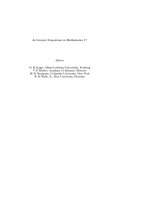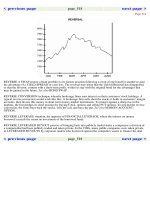Finance and Income Inequality: Test of Alternative Theories
Bạn đang xem bản rút gọn của tài liệu. Xem và tải ngay bản đầy đủ của tài liệu tại đây (102.76 KB, 25 trang )
Finance and Income Inequality:
Test of Alternative Theories
George Clarke
Lixin Colin Xu
Heng-fu Zou*
Abstract: Although theoretical models make distinct predictions about the relation between
financial sector development and income inequality, little empirical research has been conducted
to compare their relative explanatory power. We examine the relation between financial
intermediary development and income inequality in a panel data set of 91 countries for the
period of 1960-95. Our results provide evidence that inequality decreases as economies develop
their financial intermediaries, consistent with the theoretical models in Galor and Zeira (1993)
and Banerjee and Newman (1993). Moreover, consistent with the insight of Kuznets, the relation
between the Gini coefficient and financial intermediary development appears to depend upon the
sectoral structure of the economy: a larger modern sector is associated with a smaller drop in the
Gini coefficient for the same level of financial intermediary development. However, there is no
evidence of an inverted-U shaped relation between financial sector development and income
inequality, as suggested by Greenwood and Jovanovic (1990). The results are robust to
controlling for biases introduced by simultaneity.
JEL Classification: D3, G2, O1
Keywords : Income inequality; financial intermediary development; Kuznets curve
World Bank Policy Research Working Paper 2984, March 2003
The Policy Research Working Paper Series disseminates the findings of work in progress to encourage the exchange
of ideas about development issues. An objective of the series is to get the findings out quickly, even if the
presentations are less than fully polished. The papers carry the names of the authors and should be cited
accordingly. The findings, interpretations, and conclusions expressed in this paper are entirely those of the authors.
They do not necessarily represent the view of the World Bank, its Executive Directors, or the countries they
represent. Policy Research Working Papers are available online at .
*
All authors are affiliated with the Research Department of the World Bank. We thank Jerry Caprio, Robert Cull,
Ross Levine, and Mattias Lundberg for comments. We are especially grateful to Thorsten Beck in early
collaboration in this project, help in collecting and compiling data, and many useful discussions.
I.
INTRODUCTION
Economists have been concerned about the distribution of income for a long time.
Kuznets (1955), which is perhaps the seminal study on the distribution of income, argued that
economic development is associated first with an increase and then a decrease in income
inequality, resulting in an inverted u-shaped relationship between the two variables. In the
1990s, economists started to consider the link between financial sector development and income
inequality. Building on the Kuznets’ hypothesis, Greenwood and Jovanovic (1990) show how
the interaction of financial and economic development can give rise to an inverted u-shaped
relationship between income inequality and financial intermediary development. Other models,
however, have shown that financial market imperfections can perpetuate the initial distribution
of wealth in the presence of indivisible investments (Banerjee and Newman, 1993; Galor and
Zeira, 1993), suggesting a negative relationship between the two. While the recent empirical
literature has established a positive impact of financial development on economic growth, less is
known about the empirical link between finance and income distribution. 1
This paper analyzes the relationship between income distribution and financial
intermediary development using panel data from both developing and developed countries
between 1960 and 1995, Specifically, we analyze whether financial intermediary development
has an impact on income inequality and whether this impact depends on the level of financial
intermediary development or the sectoral structure of the economy, as implied by alternative
1
For the relationship between financial development and growth see, among others, Beck et al. (2000b), Levine et
al. (2000) and Rousseau and Wachtel (2000). In addition, see Li et al. (1998), and Li et al. (2000) for the
relationship between income inequality and financial sector development. None of these papers aims to test for the
1
existing theories. We allow for a non- linear relationship between financial sector development
and income inequality. Since causation could run either from financial sector development to
inequality or from initial inequality to financial sector development, we attempt to allow for
endogeneity using instruments for financial sector development suggested in the financial sector
development-growth literature (see, for example, Levine, 1997b, 1999).
The empirical investigation yields several results. First, on average there appears to be a
negative relationship between financial sector development and income inequality.
This is
consistent with the conjecture in Banerjee and Newman (1993) and Galor and Zeira (1993).
Second, we find little evidence to support the Greenwood-Jovanovic hypothesis of an inverted ushaped relationship between inequality and finance.
Third, consistent with insights based on
Kuznets (1955), sectoral structure appears to affect how financial intermediaries impact
inequality. In particular, the inequality-reducing effects of financial intermediaries is muted in
countries with larger modern (i.e., non-agricultural) sectors.
The relationship between financial development and income distribution is important for
policy makers.
While recent work has established a robust link between financial sector
development and economic growth, policy makers are also interested in the distribution of the
benefits of accelerated growth. Moreover, given concerns about income distribution per se, a
policymaker faced with certain policy options may wish to know how policies affect both growth
and income distribution. Finally, it is important for policy makers to know whether finance can
be used as an instrument to affect income inequality and in what context it might be useful in
doing so.
distinct implications of alternative existing theories regarding income distribution and financial sector development,
2
The remainder of the paper is organized as follows. We review the theoretical literature
on the relationship between income inequality and financial sector development in section 2 and
discuss the data that we use to test the theoretical hypotheses in section 3. After discussing the
empirical model specification and some estimation issues in section 4, we present empirical
results in section 5 and conclude in section 6.
II.
THEORETICAL PERSPECTIVES ON FINANCE AND INEQUALITY
Several recent models suggest that capital market imperfections might affect income
inequality during economic development. For example, Greenwood and Jovanovic (1990)
present a theoretical model in which financial development fosters economic development,
which, in turn, facilitates necessary investment in financial infrastructure. In their model, agents
operate the more profitable, but more risky, of two technologies only when they can diversify
risk by investing in financial intermediary coalitions.
However, the fixed costs (e.g.,
membership fees) associated with these coalitions prevent low- income individuals from joining
them. Assuming that poor individuals save less, and thus accumulate wealth more slowly,
income differences between (high- income) members of intermediary coalitions and (lowincome) outsiders will widen, resulting in an increase in income inequality. However, since the
entrance fee is fixed, all agents eventually join these coalitions, resulting in an eventual reversal
in the upward trend.
Consequently, Greenwood and Jovanovic’s (1990) model predicts an
inverted u-shaped relationship between income inequality and financial sector development, with
income inequality first increasing and then decreasing – before eventually stabilizing – as more
people join financial coalitions (the inverted u-shaped hypothesis).
as intended by this paper.
3
Contrary to Greenwood and Jovanovic (1990), Banerjee and Newman (1993) and Galor
and Zeira (1993) suggest that long-run convergence in the income levels of rich and poor will not
necessarily happen in economies with capital market imperfections and indivisibilities in
investment in human or physical capital. Depending on the initial wealth distribution, income
inequality might persist. Galor and Zeira (1993) construct a two-sector model with bequests
between generations, where agents who make an indivisible investment in human capital can
work in a skill- intensive sector. However, given capital market imperfections, only individuals
with bequests larger than the investment amount or who can borrow will be able to make this
investment. This results in income inequality that is perpetuated through bequests to the next
generation.
In their model, an economy with capital market imperfections and an initially
unequal distribution of wealth will maintain this inequality and grow more slowly than a similar
economy with a more equitable initial distribution of wealth. Similarly, Banerjee and Newman
(1993) construct a three-sector model, in which two of the technologies require indivisible
investment. Due to capital market imperfections, only rich agents can borrow enough to run
these indivisible, higher-return technologies. Once again, the initial distribution of wealth has
long-run effects on income distribution and growth. Holding all else equal, these models suggest
that countries with larger capital market imperfections (i.e. higher hurdles to borrow funds to
finance indivisible investment) should have higher income inequality. Consequently, we should
observe a negative relationship between financial development and income inequality (the linear
hypothesis).
The predictions of these models can also be combined with the insights of Kuznets
(1955) to suggest potential links between the sectoral structure of the economy, financial sector
development, and income inequality. Focusing on the transition from agriculture to industry,
4
Kuznets (1955) conjectured that there might be an inverted u-shaped relationship between
income inequality and economic development. As people move from the low- income, but more
egalitarian, agricultural sector to the high- income, but less egalitarian, industrial sector, income
inequality initially increases. However, as the agricultural sector shrinks and agricultural wages
increase, this trend reverses and income inequality decreases. 2 More general models involving a
traditional sector with a simple technology and a modern sector that employs an advanced
technology that requires familiarization and possibly re-education before adoption can make
similar predictions (Aghion and Howitt, 1998; Helpman, 1998). Since only a minority of people
initially benefit from the higher income possibilities in the modern sector, income inequality
increases at the initial stage of economic development. However, as more people adopt the new
technology, and as new entrants catch up with those who started earlier, this reverses and income
inequality starts to fall.
Financial sector development might affect income inequality if agents require access to
finance in order to migrate to the modern sector. Since, as suggested by Kuznets (1955), income
inequality is likely to be higher in the modern sector (industry and services), and if entry into this
sector is made easier when it is easier to gain access to finance, inequality will be greater in
economies with larger modern sectors. Further, if highly talented individuals can garner larger
rewards in the modern sector, these individuals might be able to gain especially large rewards
when they have easier access to finance, resulting in greater within-sector income inequality in
the modern sector than would have been possible in the traditional sector.
Consequently,
inequality will be higher in countries with large modern sectors and greater financial depth than
2
See also the analysis by Lewis (1954) and Todaro (1969) who formally model the idea.
5
in countries with only one (or neither) of these characteristics. In other words, holding constant
the direct impact of financial sector development on inequality, the coefficient on an interaction
term between financial depth and the size of the modern sector would be positive. We thus
arrive at the augmented Kuznets hypothesis: sector structure will affect how financial depth
impacts inequality. In particular, we expect a positive interaction between financial depth and
the importance of the modern sector (as characterized by industry and service sectors).
Theory thus makes different predictions about the relation between financial
intermediaries and income inequality. In the following, we use data from a broad cross-section
of countries between 1960 and 1995 to assess the empirical validity of the different hypotheses.
III.
DATA
This section describes our indicators and data for financial intermediary development and
income inequality as well as the set of conditioning information. Table 1 presents descriptive
statistics and correlations. 3 The income inequality data are based on a new data set of Gini
coefficients compiled by Deininger and Squire (1996) and extended by Lundberg and Squire
(2000). While the original data set contained over 2,600 observations, Deininger and Squire
(1996) and Lundberg and Squire (2000) limited the data set by imposing several quality
conditions. First, all observations had to be from national household surveys for expenditure or
3
The sample includes Australia, Austria, Belgium, Brazil, Canada, Chile, Colombia, Germany, Denmark, Ecuador,
Egypt, Spain, Finland, France, United Kingdom, Greece, Hong Kong (China), Indonesia, India, Ireland, Italy,
Jordan, Japan, Kenya, Korea, Sri Lanka, Mexico, Malaysia, Nigeria, Netherlands, Norway, New Zealand, Pakistan,
Peru, Philippines, Portugal, Singapore, Sweden, Thailand, Turkey, United States of America, Venezuela, South
Africa, Zimbabwe
6
income. Second, the coverage had to be representative of the national population. Third, all
sources of income and uses of expenditure had to be accounted for, including own consumption. 4
To explore whether there is an inverted U-shaped relation between economic
development and income inequality, as proposed by Kuznets, we regress the logarithm of the
Gini coefficient on the log of real per capita GDP and its square. Figure 1 shows the result for
the panel sample. The graph suggests the existence of an inverted U-shaped curve. However,
this graph does not control for alternate explanations of income inequality, such as financial
depth.
The recent literature on the relationship between financial intermediary development and
economic growth has developed several indicators to proxy for the ability of financ ial
intermediaries to identify profitable projects, monitor and control managers, ease risk
management and facilitate resource mobilization. We concentrate on credit to the private sector
by financial intermediaries over GDP (private credit). This indicator, which comprises credits to
private firms and households from banks and non-bank financial intermediaries (but which
excludes central banks as lenders and government and state-owned enterprises as borrowers),
seems a good proxy variable for the extent to which private sector agents have access to financial
intermediation (as in Greenwood and Jovanovic, 1990), or access to loans (as in Banerjee and
Newman, 1993; Galor and Zeira, 1993). Many recent studies have shown that growth is faster in
countries where private credit is higher (see, for example, Beck et al., 2000b; Levine et al.,
2000). To assess the robustness of our results, we also use an alternative measure of financial
4
To account for different sampling methods, we adjust the data using a method suggested by Deininger and Squire
(1996), and als o applied by Li et al. (1998) and Lundberg and Squire (2000). Specifically, Deininger and Squire
7
intermediary development – claims on the non-financial domestic sector by deposit money banks
divided by GDP (bank assets). In contrast to private credit, this measure excludes credits by nonbank financial intermediaries but includes credits to governments and state-owned enterprises.
Our sample shows a large variation in financial intermediary development. Private credit
ranges from 5% of GDP in Chile (1970-75) to over 200% in Japan (1990-95). The two
indicators of financial intermediary development are positively and significantly correlated (see
Table 1).
The pairwise correlations indicate that income inequality is lower in countries with
deeper financial markets; both indicators of financial sector development are significantly and
negatively correlated with the Gini coefficient. To visualize the relation between the Gini
coefficient and financial intermediary development, Figure 2 plots the logarithm of the Gini
coefficient and the fitted value from the regression of the logarithm of the Gini Coefficient on the
logarithm of private credit against the logarithm of private credit. The plot in Figure 2 suggests a
negative, and possible non- linear, relationship between financial sector development and income
inequality.
IV.
EMPIRICAL FRAMEWORK
To further explore the relationship between financial intermediary development and
income inequality, we estimate the following regression.
ln(Gini Coef.it ) = α 0 + f ( Financeit ) + α 2CVit + ε it
(1)
(1996) find a systematic difference of 6.6 points between the means of income-based and expenditure-based Gini
coefficients. We therefore add 6.6 points to the expenditure-based Gini coefficients.
8
As discussed previously, bank assets or claims on the private sector by financial institutions
(private credit) – both as a share of GDP – are the measures of financial sector development used
in this study.
The focus of the analysis is f(Finance it) which, based upon the discussion of
theoretical models linking income distribution to financial sector development, we assume has
the following functional form:
α 11Finance it + α 12 Finance it + α 13Finance it * Modern it
2
Modern is value added in industry and services (i.e., non-agricultural) sectors over GDP. The
linear hypothesis predicts α 11 <0 and α12 =0, but makes no predictions about α 13 . The inverted ushaped hypothesis predicts α 11 >0 and α 12 <0, but again makes no predictions about α 13 . The
augmented Kuznets hypothesis predicts α 13 >0.
In addition to the financial sector variables, we include several variables to control for
other factors that might affect inequality.
Specifically, we include linear and squared terms of
the log of (initial) real per capita GDP to control for a direct “Kuznets-effect” of economic
development on income inequality that is independent of any effect of financial intermediary
development. We also include the inflation rate conjecturing that monetary instability hurts the
poor and the middle class relatively more than the rich, because the latter have better access to
financial instruments that allow them to hedge their exposure to inflation. 5 We therefore expect
inflation to have a positive coefficient. Finally, we include measures of government
consumption, ethno-linguistic fractionalization and a measure of the protection of property rights
(the risk of expropriation). We might expect income inequality to be higher in countries where
5
See, for example, Easterly and Fischer (2001).
9
ethnic fractionalization is greater if, for example, people are averse to redistribution in countries
where ethnic diversity is greater. 6 It is less clear whether government consumption and the
property rights protection will increase or decrease income inequality. For example, although
the protection of property rights might protect the rich against expropriation by the poor, it could
also have the opposite effect (i.e., protecting the poor against exploitation by the rich). Similarly,
if most redistribution through the tax and transfer system is towards low- income groups,
government consumption might result in greater equality. However, it could also have the
opposite effect if rich households use their greater political power to exploit the poor. Since
Kuznets (1955) argues that income inequality depends on the sectoral structure of an economy,
we include a variable representing the share of value-added accounted for by services and
industry (as opposed to agriculture). The correlation of the modern (i.e., non-agricultural sector)
share of GDP and GDP per capita indicates that richer countries have smaller agricultural
sectors. Although the simple correlation between the modern sector’s share of GDP and the Gini
coefficient is negative, this appears to be because poorer countries have greater inequality and
larger agricultural sectors.
After controlling for per capita income, the partial correlation
becomes positive and significant.
Following the convention of the vast majority of cross-country empirical studies, we split
the sample period 1960-95 into seven non-overlapping 5- year periods. We use 5-year periods
rather than shorter time spans because while financial intermediary data are available on a yearly
basis for most countries in our sample, they might be subject to business cycle fluctuations,
which we can control for by averaging over longer time periods. To take account of the panel
6
Consistent with this Alesina et al. (1999) find that spending on productive public goods (e.g., on schools) is lower
in US cities where ethnic diversity is greater.
10
structure of the data, we considered using random or fixed effects estimators. However, in this
case it is not clear that fixed effects estimation would be appropriate. The major problem is that
the fixed-effects estimator, which focuses on within-country variation of financial development
and income inequality, might seriously exacerbate problems related to measurement error
(Griliches and Hausman, 1986). Since income inequality tends to change relatively slowly over
time and is often poorly measured, it is likely that measurement error would be a significant
problem in fixed-effects estimation. 7 We did, however, estimate the model allowing for random
effects.
The results from this estimation were very similar in terms of size and statistical
significance to the results from OLS. 8
Estimating equation (1) with Ordinary Least Squares (OLS) would introduce various
biases since OLS does not allow for the possibility of reverse causality—that is, for the
possibility that inequality affects the provision of financial services—something suggested in
some of the theoretical models. For example, in Greenwood and Jovanovic’s (1990) model, the
initial distribution of wealth affects who is able to join financial intermediary coalitions and,
therefore, might affect the size of the financial sector. Since we are primarily interested in the
effect of financial sector development on income inequality, we use an instrumental variables
approach – adopting instruments for financial sector development similar to the ones used in
Levine (1997b; 1999), which assesses the exogenous impact of financial intermediary
development on economic growth. The instruments are a set of dummy variables proposed by
7
Further, as noted by Easterly (2002), it is unclear whether standard panel methods are appropriate given that
income distribution is relatively stable over time.
8
Results are available from authors upon request.
11
La Porta et al. (1998) that identify the origin of the country’s legal system. 9 We use the legal
origin dummy variables, rather than the measures of creditor rights, also proposed by La Porta et
al. (1998), because they are available for a wider sample of countries. Several papers have
shown that differences in legal origins are significantly related to financial sector development,
perhaps because different legal traditions put different levels of emphasis on the rights of
property owners or because some systems are more adaptable to exogenous changes than
others. 10 In the empirical analysis, we examine the validity of the instruments using Hansen’s Jtest to test the over- identifying restrictions. 11
V.
EMPIRICAL R ESULTS
V.1
Main Results
To test the linear hypothesis suggested by Galor and Zeira (1993) and Banerjee and
Newman (1993), we regress the natural log of the Gini coefficient on linear terms for the two
measures of financial sector development, private credit and bank assets, and the additional
control variables. Before we control for the possible endogeneity of the measures of financial
sector development, the results are not consistent across the two measures (see column 1 of
Table 2 for private credit and column 1 of Table 3 for bank assets). The coefficient on private
9
The measures of legal origin were taken from the Global Development Network Growth Database produced by
William Easterly and Mirvat Sewadeh (see Easterly, 2001).
10
Beck et al., (2001) provide an excellent summary of much of the empirical and theoretical literature on this topic.
La Porta et al. (1998) show that protection for corporate shareholders and creditors are strongest in common law
countries and weakest in French Civil Law countries. La Porta et al. (1997) relates these variables to some measures
of capital market development (external market capitalization over GDP, number of listed firms per capita, initial
public offerings), showing that they are generally lower in civil law (especially French Civil law) countries than in
common law countries. Beck et al. (2001) shows that private credit is lower in French Civil law countries than in
German Civil law and Common law countries.
11
In similar regressions of financial sector development on economic growth, Levine (1997b; 1999) fails to reject
the null hypothesis that the over-identifying restrictions are valid.
12
credit is statistically significant and positive when private credit is used as the measure of
financial sector development, while the coefficient on bank assets is statistically significant but
negative when bank assets is used as the measure of financial sector development.
However, after controlling for endogeneity using the indicators of legal origin as
instruments (see Section IV), the coefficients on both variables are negative and statistically
significant, suggesting that financial sector development reduces income inequality. We are
unable to reject the null hypothesis that the legal origin dummies are uncorrelated with the error
term after controlling for the other control variables, suggesting that they are appropriate
instruments (see Hansen J-Stats in Table 2 and Table 3). Based upon the coefficient estimates in
column 1, a 1 percent increase in private credit or bank assets results in about a 0.25 percent
decrease in the Gini coefficient. To test the inverted u-shaped hypothesis, we include a squared
term for the measures of financial sector development (see column 5). Since the coefficient on
the squared term is never statistically significant in any model specification, the results fail to
provide any support for this hypothesis.
After controlling for endogeneity for the financial sector variables, many of the
coefficients on the other control variables are statistically insignificant (see column 4 of Table 2
and Table 3). However, the coefficients on both the linear and squared terms for initial GDP per
capita are statistically significant. The positive coefficient on the linear term and the negative
coefficient on the squared term suggest an inverted u-shape, with income inequality increasing
with income at low levels of income and decreasing at high levels. Based upon the coefficients
in column 4 of Table 2, the turning point is at about $2350. When private credit is used as the
measure of financial sector development, the coefficient on government consumption is
statistically significant and negative, suggesting that income inequality might be lower in
13
countries with higher government spending. However, this final result is not robust to using
bank assets as the measure of financial sector development (see Table 3).
Finally, the results appear to provide some support for the Kuznets’ hypothesis that
income inequality increases during the transition from agriculture to industry. After controlling
for other factors that might affect income inequality, including per capita income and financial
sector development, the coefficient on the share of the economy accounted for by services and
industry (i.e., sectors other than agriculture) is positive and statistically significant.
This
suggests that income inequality is lower in countries where agriculture accounts for a greater
share of GDP.
To test the augmented Kuznets’ hypothesis that financial sector development might have
a greater effect on income inequality in countries with smaller modern sectors, we include an
interaction between value added in industry and services and the measures of financial sector
development. Consistent with this hypothesis, the coefficient on the interaction between finance
and value-added in the modern (i.e., non-agricultural) sector of the economy is positive when
either bank assets or private credit is used as the measure of financial sector development (see
column 6 in Table 2 and Table 3). However, it is statistically significant only when private
credit is used as the measure of financial sector development. Based upon the point estimates of
the coefficients in column 6 of Table 2, financial sector development reduces income inequality
so long as the modern sector accounts for less that 99.6 percent of GDP – slightly lower that the
maximum value observed in the sample. At the sample mean for value added in the modern
sector (87.4 percent of GDP – see Table 1), a 1 percent increase in private credit reduces
inequality by 0.3 percent. Similarly, based upon the point estimates, an increase in the size of
the modern sector will increase inequality whenever private credit accounts for over 14 percent
14
of GDP – far below the sample mean but fractionally higher than the sample minimum (see
Table 1). In summary, financial sector development reduces inequality most in countries with
relatively small ‘modern’ sectors, while increases in the size of the modern sector increase
inequality most in countries with more developed financial markets. Based upon the point
estimates of the coefficients in Table 2, however, it is important to note that increases in financial
depth will decrease inequality for almost all of the countries in the sample, while increases in the
size of the modern sector will increase inequality for most of the countries in the sample.
To summarize the empirical results, we find strong evidence to support the linear
hypothesis that inequality is lower in countries with better-developed financial sectors. Further,
we also find some evidence that supports the augmented Kuznets hypothesis – inequality is
generally higher in countries with smaller agricultural sectors (i.e., larger industrial and service
sectors) and that this effect appears stronger in countries with more developed financial sectors.
In contrast, we do not find any support for the inverted u-shaped hypothesis. When squared
terms for the indicators of financial sector development are included in the base specification, the
coefficients on these terms are statistically insignificant.
VI.
CONCLUSIONS
There has been little systematic empirical study on the relationship between finance and
inequality. This paper attempts to examine this issue by testing empirically distinct predictions
made by alternative theories. Specifically, Galor and Zeira (1993) and Banerjee and Newman
(1993) predict a negative and linear relationship between finance and the Gini coefficient (the
linear hypothesis), while Greenwood and Jovanovic (1990) suggest an inverted U-shaped
relationship (the inverted-U shaped hypothesis). In addition, an important insight of Kuznets
15
(1955)—that the sectoral structure is important for the relation between economic development
and income inequality—suggests that finance might reduce inequality to a lesser extent in
countries with larger modern sectors (i.e., smaller agricultural sectors). Exploring the link
between indicators of financial intermediary development and the Gini coefficient in a large
cross-country sample for the period 1960-95, we experiment with both simple specifications and
more sophisticated specifications that control for simultaneity. Overall, our results provide
reasonably strong support for the linear and somewhat more modest support for the augmented
Kuznets hypotheses. We find a significant negative coefficient on the measures of financial
intermediary development, while we find a positive interaction of finance with the size of the
modern sector. The results are least consistent with the inverted-U shape hypothesis—the
coefficient on the squared term for the financial intermediary indicators is never statistically
significant and, in fact, often has the wrong sign.
Overall, our results suggest that the growth-spurring effects of financial intermediary
development are likely to be associated with positive effects on aggregate income dis tribution as
well. 12 The dampening effect of financial intermediaries on income inequality, however, appears
to depend upon the economic structure of the economy.
We recognize some limitation of our results, which stem mostly from the limitations of
our measure of income inequality. Changes in the Gini coefficient can come about in different
ways, by absolute and relative changes in one or several of the different income quintiles. We
do not explore the impact that a higher level of financial intermedia ry development has on the
income level of a specific quintile, for instance the poor. Moreover, even results obtained by
16
using quintile data have to be regarded with caution, since they do not control for migration
between the quintiles over the sample period.
To analyze directly the effect of financial
development on specific groups of the population, one would have to use disaggregated data,
preferably at the household level. This poses new challenges for future research.
12
See Levine (1997a) for a recent literature survey on this topic. See also, Beck et al. (2001) for a discussion of
more recent results.
17
VII.
REFERENCES
Aghion, Philippe and Peter Howitt, 1998. Endogenous Economic Growth. MIT Press,
Cambridge, MA.
Alesina, Alberto; Reza Baqir and William Easterly, 1999. "Public Goods and Ethnic Divisions."
Quarterly Journal of Economics 114 (4), 1243-1284.
Banerjee, Abhijit V. and Andrew F. Newman, 1993. "Occupational Choice and the Process of
Development." Journal of Political Economy 101 (2), 274-298.
Beck, Thorsten; Asli Demirgüç-Kunt and Ross Levine, 2000a. "A New Database on the
Structure and Development of the Financial Sector." World Bank Economic Review 14
(3), 597-605.
Beck, Thorsten; Asli Demirgüç-Kunt and Ross Levine, 2001. "Legal Theories of Financial
Development." Oxford Review of Economic Policy 17 (4), 483-501.
Beck, Thorsten; Ross Levine and Norman Loayza, 2000b. "Finance and the Sources of Growth."
Journal of Financial Economics 58 (1-2), 261-300.
Deininger, Klaus and Lyn Squire, 1996. "A New Data Set Measuring Income Inequality."
World Bank Economic Review 10 (3), 565-591.
Easterly, William, 2001. "The Lost Decades: Developing Countries' Stagnation in Spite of
Policy Reform 1980-1998." Journal of Economic Growth 6 (2), 135-157.
Easterly, William, 2002. "Inequality Does Cause Underdevelopment." Working Paper #1, Center
for Global Development, Washington DC.
Easterly, William and Stanley Fischer, 2001. "Inflation and the Poor." Journal of Money, Credit
and Banking 33 (2, Part 1), 160-178.
Galor, Oded and Joseph Zeira, 1993. "Income Distribution and Macroeconomics." Review of
Economic Studies 60 (1), 35-52.
Greenwood, Jeremy and Boyan Jovanovic, 1990. "Financial Development, Growth, and the
Distribution of Income." Journal of Political Economy 98 (5), 1076-1107.
Griliches, Zvi and Jerry Hausman, 1986. "Errors in Variables in Panel Data." Journal of
Econometrics 32 (3), 93-118.
Helpman, Elhanan, ed. 1998. General Purpose Technologies and Economic Growth. MIT Press,
Cambridge, MA.
International Monetary Fund, 2002. International Finance Statistics. International Monetary
Fund, Washington DC.
18
Kuznets, Simon, 1955. "Economic Growth and Income Inequality." American Economic
Review 45 (1), 1-28.
La Porta, Rafael; Florencio López-de-Silanes; Andrei Shleifer and Robert W. Vishny, 1997.
"Legal Determinants of External Finance." Journal of Finance 52 (3), 1131-1150.
La Porta, Rafael; Florencio López-de-Silanes; Andrei Shleifer and Robert W. Vishny, 1998.
"Law and Finance." Journal of Political Economy 106 (6), 1113-1155.
Levine, Ross, 1997a. "Financial Development and Economic Growth: Views and Agenda."
Journal of Economic Literature 35 (2), 688-726.
Levine, Ross, 1997b. "The Legal Environment, Banks, and Long-Run Growth." Journal of
Money, Credit and Banking 30 (3, Part 2), 596-613.
Levine, Ross, 1999. "Law, Finance and Economic Growth." Journal of Financial
Intermediation 8 (1-2), 8-35.
Levine, Ross; Norman Loayza and Thorsten Beck, 2000. "Financial Intermediation and Growth:
Causality and Causes." Journal of Monetary Economics 46 (1), 31-77.
Lewis, W. Arthur, 1954. "Economic Development with Unlimited Supplies of Labour." The
Manchester School 22 (2), 139-191.
Li, Hongyi; Lyn Squire and Heng-Fu Zou, 1998. "Explaining International and Intertemporal
Variations in Income Inequality." Economic Journal 108 (446), 26-43.
Li, Hongyi; Lixin Colin Xu and Heng-Fu Zou, 2000. "Corruption, Income Distribution, and
Growth." Economics and Politics 12 (2), 155-182.
Loayza, Norman; Humberto Lopez; Klaus Schmidt-Hebbel and Luis Serven, 1999. "World
Saving Database." Mimeo, World Bank, Washington DC.
Lundberg, Mattias and Lyn Squire, 2000. "The Simultaneous Evolution of Growth and
Inequality." Mimeo, World Bank, Washington DC.
Rousseau, Peter L. and Paul Wachtel, 2000. "Equity Markets and Growth: Cross-Country
Evidence on Timing and Outcomes, 1980-1995." Journal of Banking and Finance 24
(12), 1933-1957.
Todaro, Michael P., 1969. "A Model of Labor Migration and Urban Unemployment in Less
Developed Countries." American Economic Review 59 (1), 138-148.
World Bank, 2002. World Development Indicators. World Bank, Washington DC.
19
VIII. FIGURES AND TABLES
log(Gini)
fitted value
4.5
4
3.5
3
4
6
8
log(GDP per capita)
Figure 1: Log (Gini) and Log(GDP per capita) in a panel of 91 countries
Note: The fitted line is from a regression of log(Gini) on the log of real per capita GDP and its square.
All data are averaged over seven 5-year periods between 1960 and 1995.
20
10
log(Gini)
fitted value
4.5
4
3.5
3
0
2
4
log(PRIVATE CREDIT)
Figure 2: Log (Gini) against Log (Private Credit) in a panel of 91 countries
Note: The fitted line is from a regression of log(Gini) on the log of Private Credit and its square.
All data are averaged over seven 5-year periods between 1960 and 1995.
21
6
Table 1: Descriptive Statistics
Gini
Coef.
Number of Observations
Private
Credit
Bank
Assets
Initial
Risk of EthnoGov’t
GDP per Exprop. linguistic Cons.
Capita
Fract.
170
170
170
170
170
Mean
37.147
51.367
46.184
6327.2
7.6646
0.2552 14.67871 0.1255
87.443
Minimum
20.459
5.246
5.338
215.7
3.3000
0.0000 5.572046 0.0072
51.454
Maximum
60.001
Gini
Coef.
Gini Coefficient
1.00
Private Credit
-0.33
170
170
Mod
Inflation
Rate Sect. Val.
Add.
170
170
202.759 141.725 20134.8 10.0000 0.8567 27.85384 1.1704
99.813
Initial
EthnoMod
Private
Bank
Risk of
Gov’t Inflation
Credit Assets GDP per Exprop. linguistic Cons.
Rate Sect. Val.
Capita
Fract.
Add.
1.00
(0.00)
Bank Assets
Initial GDP per Capita
Risk of Expropriation
Ethno-linguistic Fractionalization
Government Consumption
Inflation Rate
Modern Sector Value Added/GDP
-0.45
0.85
(0.00)
(0.00)
1.00
-0.58
0.70
0.62
(0.00)
(0.00)
(0.00)
1.00
-0.52
0.64
0.65
0.80
(0.00)
(0.00)
(0.00)
(0.00)
1.00
0.20
-0.36
-0.34
-0.46
-0.50
(0.01)
(0.00)
(0.00)
(0.00)
(0.00)
-0.46
0.28
0.29
0.62
0.49
-0.28
(0.00)
(0.00)
(0.00)
(0.00)
(0.00)
(0.00)
1.00
1.00
0.44
-0.35
-0.37
-0.30
-0.31
-0.02
-0.25
(0.00)
(0.00)
(0.00)
(0.00)
(0.00)
(0.81)
(0.00)
1.00
-0.25
0.58
0.57
0.71
0.73
-0.66
0.45
-0.06
(0.00)
(0.00)
(0.00)
(0.00)
(0.00)
(0.00)
(0.00)
(0.45)
1.00
Note. Gini = measurement-adjusted Gini coefficient from Deininger and Squire (1996) and Lundberg and Squire (2000). GDP per
capita = real per capita GDP. Source: Loayza et al. (1999). Private Credit = claims on the private sector by financial institutions
divided by GDP. Source: Beck et al. (2000a). Bank Assets = claims on domestic non-financial sector by deposit money banks
divided by GDP. Source: Beck et al. (2000a). Risk of Expropriation = Index indicating risk of expropriation through confiscation or
forced nationalization. Higher values indicate that risk is lower. Source: International Country Risk Guide collected by the PRS
Group. Ethno-linguistic Fractionalization = Average value of five indices of ethno-linguistic fractionalization, with values ranging
from 0 to 1, with higher values indicating greater fractionalization. Source: Levine, Loayza and Beck (2000). Government
Consumption = Government Consumption as share of GDP. Source: World Bank (2002). Inflation Rate = log difference of
Consumer Price Index. Source: International Monetary Fund (2002). Modern Sector Value Added/GDP = value added of service
and industrial sectors as share of GDP. Source: World Bank (2002).
drop correlation? note the negative correlation between modern sector & gini.
(alternatively, holding income level constant, the conditional correlation between Modern & Gini is positive.)
22
Table 2: Financial Intermediary Development and Income Inequality in a Panel: Private Credit
Ordinary Least Squares
Dependent Variable
Number of Observations
Number of Countries
Financial Sector Development
Private Credit
(Natural Log, as share of GDP)
Squared Private Credit
(Square of Natural Log, share of GDP)
Modern Sector*Private Credit
(Interaction Term)
Initial GDP
Initial GDP per Capita
(Natural Log)
Initial GDP per Capita Squared
(Square of Natural Log)
Other Controls
Risk of Expropriation
(Index – higher values mean lower risk)
Ethno-linguistic Fractionalization
(Higher values mean greater fractionalization)
Government Consumption
(Natural Log, Share of GDP)
Inflation
(Natural Log)
Modern Sector (Services and Industry)
(Share of GDP)
Constant
R-Squared
Generalized Method of Moments
Gini Coefficient (Natural Log)
170
44
170
44
170
44
170
44
170
44
170
44
0.0556**
(2.04)
-0.1723
(-1.13)
0.0317
(1.46)
-0.3536
(-1.50)
-0.2362***
(-3.19)
-0.0224
(-0.01)
-0.0265
(-0.09)
-1.4352**
(-2.23)
0.0046*
(1.75)
0.0144**
(2.03)
0.8242***
(4.18)
-0.0578***
(-4.70)
0.9656***
(5.01)
-0.0666***
(-5.49)
1.0736***
(4.69)
-0.0740***
(-5.09)
0.8076***
(3.38)
-0.0520***
(-3.47)
0.6807
(0.54)
-0.0444
(-0.59)
1.3866***
(2.90)
-0.0913***
(-3.02)
-0.0285**
(-2.26)
0.0919
(1.24)
-0.1007**
(-2.15)
0.2822***
(3.29)
0.0037
(1.26)
0.6993
(1.00)
-0.0281**
(-2.24)
0.0992
(1.38)
-0.0815
(-1.62)
0.2418**
(2.59)
0.0027
(0.93)
0.5804
(0.88)
-0.0308**
(-2.52)
0.1078
(1.54)
-0.0696
(-1.41)
0.2590***
(2.90)
-0.0108
(-1.17)
0.9899
(1.39)
-0.0116
(-0.76)
0.1623
(1.63)
-0.1596**
(-2.32)
-0.1275
(-0.74)
0.0082**
(2.02)
1.1797
(1.30)
-0.0138
(-0.55)
0.1558
(1.05)
-0.1745
(-1.19)
-0.0603
(-0.08)
0.0087
(1.27)
1.2926
(1.19)
-0.0275**
(-2.15)
0.2149**
(2.54)
-0.0496
(-0.68)
-0.0114
(-0.08)
-0.0379
(-1.50)
2.6746***
(3.36)
0.57
0.57
0.58
0.50
0.32
0.19
Hansen’s J-Test (Significance Level)
***, **, * denote statistical significance at the 1, 5, and 10 percent levels.
The instruments for GMM specifications are dummies indicating legal origin. The null hypothesis of the Hansen test is that the instruments are
not correlated with the error terms. White (heteroskedastic) t-statistics are reported in parentheses.
23
Table 3: Financial Intermediary Development and Income Inequality in a Panel: Bank Assets.
Ordinary Least Squares
Dependent Variable
Number of Observations
Number of Countries
Gini Coefficient (Natural Log)
170
44
Financial Sector Development
Bank Assets
-0.0439*
(Natural Log, as share of GDP)
(-1.77)
Squared Bank Assets
(Square of Natural Log, share of GDP)
Modern Sector* Bank Assets
(Interaction Term)
Initial GDP
Initial GDP per Capita
0.8074***
(Natural Log)
(4.07)
Initial GDP per Capita Squared
-0.0557***
(Square of Natural Log)
(-4.49)
Other Controls
Risk of Expropriation
-0.0199
(Index – higher values mean lower risk)
(-1.64)
Ethno-linguistic Fractionalization
0.1088
(Higher values mean greater fractionalization)
(1.41)
Government Consumption
-0.1020**
(Natural Log, Share of GDP)
(-2.08)
Inflation
0.1571*
(Natural Log)
(1.74)
Modern Sector (Services and Industry)
0.0053*
(Share of GDP)
(1.73)
Constant
0.8694
(1.21)
R-Squared
Generalized Method of Moments
0.56
170
44
170
44
170
44
170
44
170
44
-0.1402
(-0.80)
0.0140
(0.54)
-0.2557
(-1.19)
-0.2418***
(-3.55)
0.6200
(0.35)
-0.1162
(-0.49)
-1.0973*
(-1.66)
0.0024
(0.99)
0.0092
(1.26)
0.8338***
(4.08)
-0.0574***
(-4.47)
0.8870***
(4.13)
-0.0612***
(-4.47)
0.7179***
(3.11)
-0.0500***
(-3.51)
0.5557
(1.29)
-0.0395
(-1.44)
0.7498**
(2.23)
-0.0528**
(-2.47)
-0.0204
(-1.64)
0.1119
(1.43)
-0.0886
(-1.53)
0.1518
(1.62)
0.0050
(1.61)
0.9229
(1.30)
-0.0223*
(-1.85)
0.1133
(1.50)
-0.0839
(-1.59)
0.1451
(1.54)
-0.0020
(-0.24)
1.2016
(1.54)
0.0008
(0.05)
0.1411
(1.60)
-0.0662
(-1.14)
-0.0718
(-0.47)
0.0094**
(2.37)
1.3227
(1.54)
-0.0013
(-0.08)
0.1087
(0.94)
-0.1891
(-0.71)
0.0500
(0.20)
0.0105**
(2.24)
0.6339
(0.41)
-0.0084
(-0.52)
0.1778**
(2.04)
-0.0334
(-0.40)
-0.1367
(-0.77)
-0.0165
(-0.66)
3.6491***
(2.82)
0.56
0.56
0.81
0.72
0.71
Hansen’s J-Test (Significance Level)
***, **, * denote statistical significance at the 1, 5, and 10 percent levels.
The instruments for GMM specifications are dummies indicating legal origin. The null hypothesis of the Hansen test is that the instruments are
not correlated with the error terms. White (heteroskedastic) t-statistics are reported in parentheses.
24









